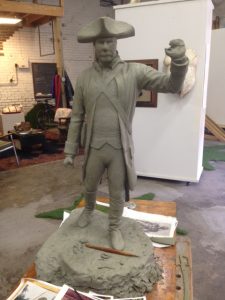By Keith Waits
Entire contents copyright © 2017 Keith Waits. All rights reserved.
“The word ‘deface’ derives from ancient Rome,” explains sculptor Matt Weir, “where the public would smash away the faces on images of leaders after they had been disgraced. Emperors would have statues of themselves everywhere, and if they were overthrown they were erased.”
In the aftermath of the events in Charlottesville, Virginia, Louisville joined other American communities in the struggle over public monuments honoring Confederate leaders when the statue of General John Breckinridge Castleman near the Cherokee Triangle was vandalized with bright orange paint. Within days Showing Up For Racial Justice organized a passionate but peaceful public demonstration at the location, and Louisville Mayor Greg Fischer issued a statement directing the Commission on Public Art (COPA) to conduct a review of all public statues in the Metro area to determine what issues need to be addressed.
It seems a worthwhile and important response to community outcry, but in all of the press generated, there has been very little written about how artists feel about all of this, especially sculptors of public art who are today creating such monuments.

Early iteration of Matt Weir’s statue of Colonel William Oldham. Photo by Keith Waits.
Matt Weir is working to complete a commission for a historical statue in Oldham County that will commemorate Colonel William Oldham, a Revolutionary war figure for whom the county is named. The statue, which will be approximately seven feet tall, is to be installed in front of the LaGrange Library by July 2018. The uniformed figure is captured in a humble posture, rifle resting on his shoulder, and the horse’s bit and bridle dangling from his right hand is a nod to the tradition, missing here by deliberate choice, of showing military figures atop a stallion.
The weary, home-from-the-front attitude is a contrast to the heroic Castleman on horseback but reflects the common, everyman quality of the history. Weir states that Oldham has no significant military accomplishments of note, and he was killed in his early 30’s at The Battle of the Wabash, in which his unit was decimated by Native Americans onto whose land they had entered as part of a troop movement north. “There is a sense that he would have likely served as a public official if he had lived,” Weir says. “It’s unclear exactly how they came to name the county after him, but there is really no public sculpture in Oldham County, and Judge David Voegele (who commissioned the statue) wanted to change that, and this seemed like a good place to start.”
When asked about his feelings on the issue, and the Castleman statue in particular, Weir speaks in thoughtful terms that reflect his conflicted feelings: “Some of these pieces that are coming down in Baltimore and Durham, to my eye, looked like beautiful work; examples of important sculptural techniques, and, as an artist, I do feel sad they are disappearing. The Castleman statue is, I think, the only horse and rider statue in Louisville, and it’s a landmark that the neighborhood has used for a long time in its branding.” Weir shows me a cup from the Cherokee Triangle Art Fair showing the event logo that incorporates an image of the statue.

Ed Hamilton at work in his studio. Photo by Sarah Katherine Davis/courtesy of LVA.
Ed Hamilton has made his reputation as a sculptor of memorial statues, primarily recognizing African American History, and he echoes these thoughts in his own observations: “As an artist, we need to look at work, and I had studied the Castleman statue over the years because it is a gracious, artistically rendered piece. I didn’t even realize for a long time that it was a Confederate officer because he is not wearing a designated uniform. But now I need to rethink the underlying meaning of that statue.” Hamilton’s most recent work, a bust of Underground Railroad conductor George DeBaptiste, is for Madison, Indiana. Among his other monuments are The Spirit of Freedom, a memorial to black Civil War veterans that stands in Washington, DC, as well as monuments dedicated to Booker T. Washington, Joe Louis, York (William Clark’s manservant on the Lewis and Clark Expedition), and the slaves who revolted on the Amistad.
Hamilton is a member of COPA, and he says that the commission will follow the process that they took in making a recommendation on the statue at the University of Louisville that was relocated to Brandenburg Kentucky. “We have scheduled six meetings, public forums where different opinions can be represented. COPA will not itself make any decisions, but we will be a conduit for the people to weigh in, and we will make recommendations to the Mayor’s office.”
COPA has set up a link for the public to provide comments here.
These kinds of public sculptures demand substantial research, often as a part of a proposal the artist submits before they even know if they have the job. “It is a job,” Weir tells me. ”I do personal work which reflects my particular aesthetic, and that that is very different from this sort of commission, but my name is on that statue forever, so I want to feel good about it. We don’t know exactly how long bronze lasts, but the oldest surviving bronze statue is thought to be 6000 years old.”
But would he take a commission for a statue honoring a Confederate figure? “For me, personally, no, I wouldn’t do it.”

Ed Hamilton’s statue of York, who was part of the Lewis & Clark expedition.
Historically bronze statues are almost always tributes to individuals of power and influence. The cost of such projects means they are often driven by wealth and privilege, and the innumerable Confederate statues throughout the United States are inextricably tied to a campaign to reinforce Jim Crow laws across the American South in the years between 1890 and 1920, a period often referred to as “the nadir of race relations in America” by historians, so there should be no mystery about their original intention. More were erected in the late 1950’s and early 1960’s as a response to the Civil Rights Movement. “What’s happening now is reactionary,” claims Weir. “Just as the statues themselves were reactionary. Idolatry through figurative art has always been reactionary – always driven by the new regime.”
When I ask him how he feels about the Durham statue being pulled down in the dark of night, he offers: “As a sculptor, that really hit home – what if that were MY work? I would rather see these changes occur through public dialogue. It’s an opportunity to heighten awareness of public art and the issues surrounding these Confederate monuments.”
“Whatever happens,” observes Weir, ”it seems like there is no win here.”

Matt Weir at work on the statue of Colonel William Oldham. Photo by Keith Waits.
Keith Waits is a native of Louisville who works at Louisville Visual Art during the days, including being the host of PUBLIC on WXOX-FM 97.1/ ARTxFM.com, but spends most of his evenings indulging his taste for theatre, music and visual arts. His work has appeared in Pure Uncut Candy, TheatreLouisville, and Louisville Mojo. He is now Managing Editor for Arts-Louisville.com.





